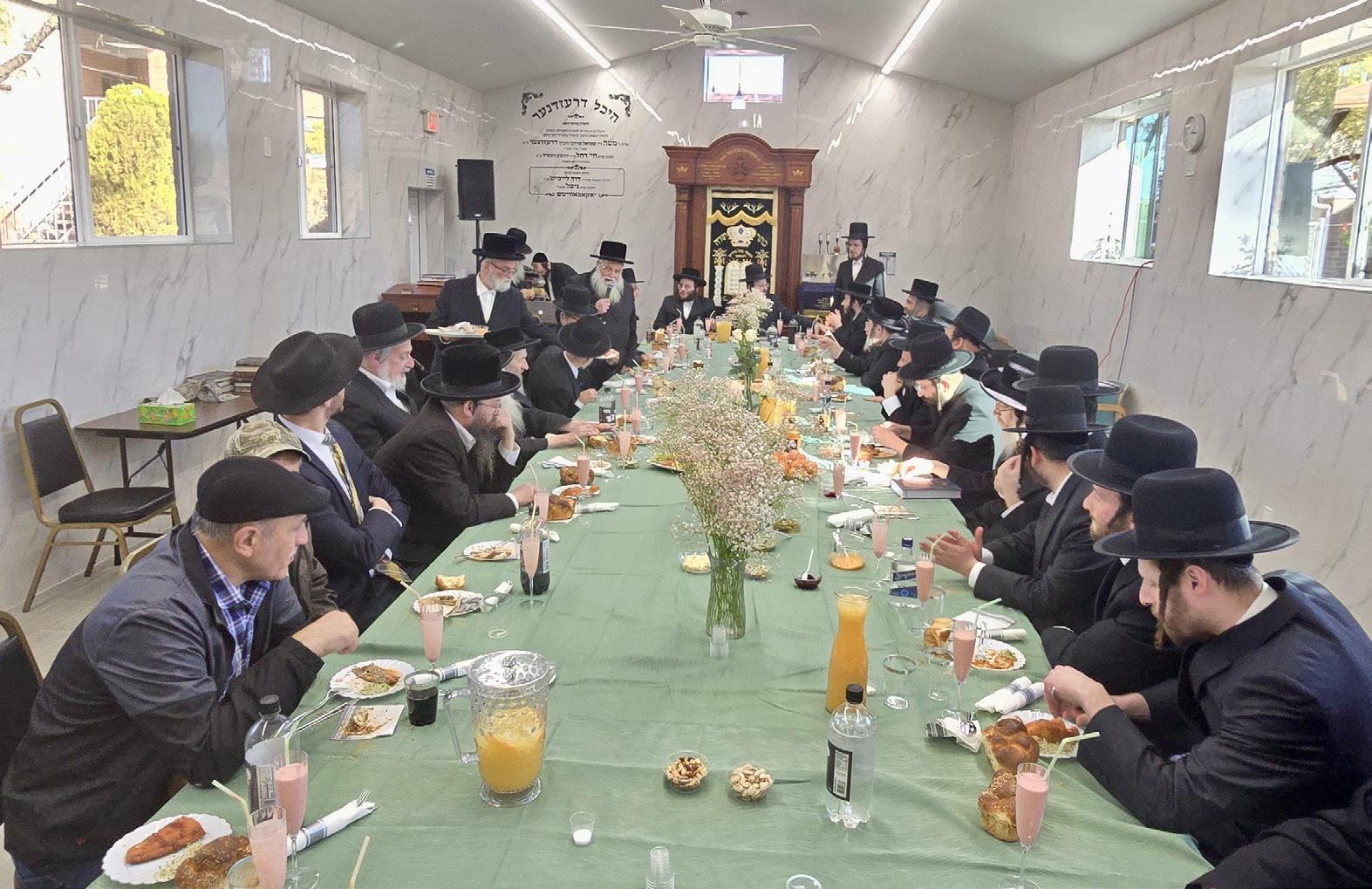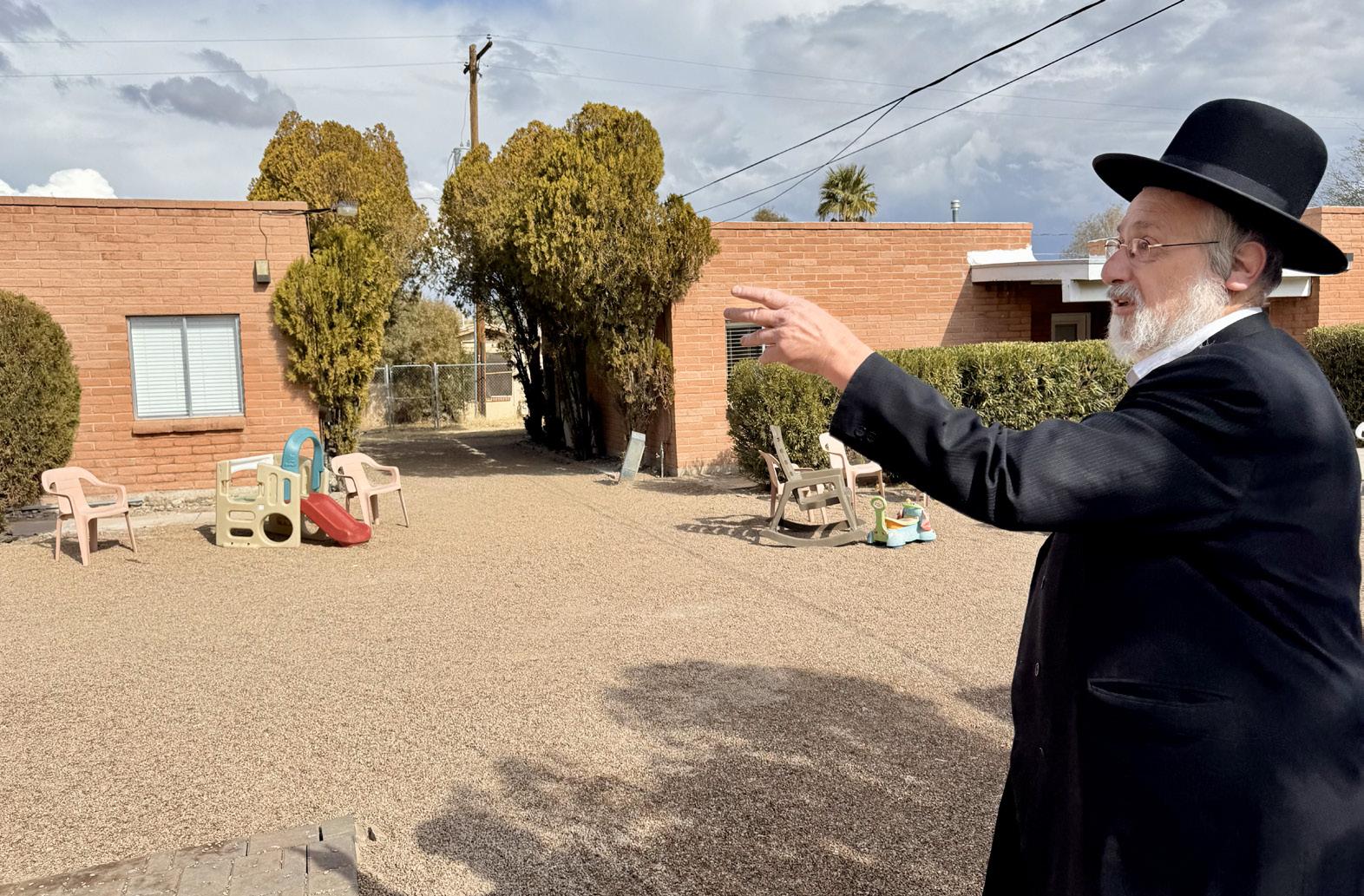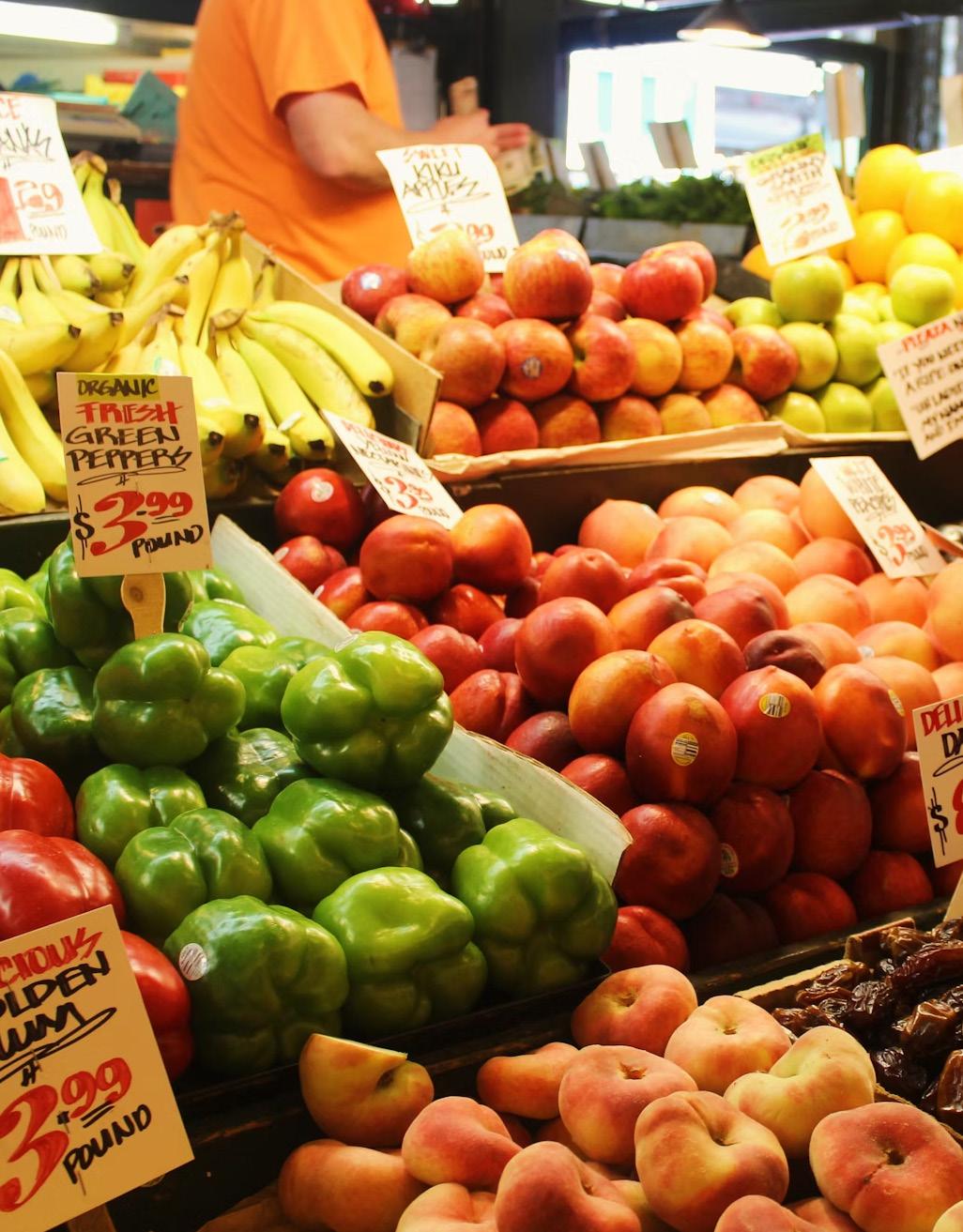

Strategic Discomfort
Lessons on growth from Chabad outreach
Moroccan Dafina
A satisfying stew for a chilly winter Shabbat
The Confidante



Strategic Discomfort
Lessons on growth from Chabad outreach
Moroccan Dafina
A satisfying stew for a chilly winter Shabbat
The Confidante
For more than 50 years, devout families from New York bask in Tucson’s winter sunshine


The Jewish outreach and education network of Southern Arizona 2443 E 4th Street, Tucson, AZ 85719
EXECUTIVE DIRECTOR
Rabbi Yossie Shemtov
REBBETZIN
Chanie Shemtov
OUTREACH DIRECTOR
Rabbi Yehuda Ceitlin
PROGRAM DIRECTOR
Feigie Ceitlin
Affiliates: Congregation Young Israel, Chabad at the University of Arizona, Chabad on River, Chabad of Oro Valley, Chabad of Sierra Vista, Chabad of Vail and Lamplighter Chabad Day School of Tucson

EDITOR
Rabbi Yehuda Ceitlin
COPY EDITOR
Suzanne Cummins
CONTRIBUTING WRITERS
Feigie Ceitlin, Menachem Posner, Sarah Chana Radcliffe, Mordechai Schmutter, David Sears, Benjamin Weiss
PHOTOS
Unsplash.com
SPECIAL THANKS Chabad.org
EDITORIAL & ADVERTISING
Phone: 520-881-7956 #12
Email: info@ChabadTucson.com
SUBSCRIPTION: ChabadTucson.com/SubscribePrint
Keeping Jewish is published in print periodically by Chabad Tucson and is distributed free in Tucson and Southern Arizona.
Chabad Tucson does not endorse the people, establishments, products or services reported about or advertised in Keeping Jewish unless specifically noted. The acceptance of advertising in Keeping Jewish does not constitute a recommendation, approval, or other representation of the quality of products or services, or the credibility of any claims made by advertisers, including, but not limited to, the kashrus of advertised food products. The use of any products or services advertised in Keeping Jewish is solely at the user’s risk and Chabad Tucson accepts no responsibility or liability in connection therewith.
Note: “G-d” and “L-rd” are written with a hyphen instead of an “o .”
This is one way we accord reverence to the sacred divine name. This also reminds us that, even as we seek G-d, He transcends any human effort to describe His reality.
As a youngster in Montreal, Canada, my friends and I would often go to the Van Horne Shopping Center and offer Jewish passersby the opportunity to put on tefillin. It was a bit intimidating to stop a stranger and ask, “Are you Jewish?” We never knew whether we would receive a welcoming smile or a gruff comment.
These days, my daughter Goldie and her friends often visit the Biltmore Fashion Park in Phoenix, Arizona. In a similar fashion, they ask passersby if they are Jewish, and if they are, they hand them a pair of Shabbos candles to light on Friday night. They, too, get a mixed range of responses.
Despite a 30-year gap, our Mitzvah outreach activities share a common goal and benefit. They provide fellow Jews with opportunities to perform a mitzvah, while empowering Chabad youth to step out of their comfort zones.
Both of these objectives were initiated by the Rebbe and articulated by him in the first sermon he gave upon accepting the leadership of the Chabad-Lubavitch movement in 1951.
Opening with the verse “I have come to my garden…” (Song of Songs 5:1), the Rebbe encouraged and empowered us to transform the world for the better. Drawing on the teachings of Kabbalah and Chassidus, he interpreted the “garden” as our physical world and explained how it is specifically here that Hashem ultimately desires to be felt and experienced. The true spiritual essence was concealed following Creation, and it is our task to reveal it through our actions.
The opening verse of the Rebbe’s sermon offers additional insight into this concept. It speaks of “coming to the garden” rather than “coming home.” This distinction is significant. A home represents stability,
By Rabbi Yehuda Ceitlin

comfort, and seclusion; a garden represents growth, discovery, and uncertainty. By entering the garden, one ventures out of their comfort zone and uncovers the divine presence in the universe.
We all desire comfort, yet that is not the goal Hashem has for us. A joke is told about a Jewish man visiting the chiropractor due to his painful bones and joints. While treating him, the chiropractor inquires, ‘Are you comfortable?’ to which the man answers, ‘I make a living...’
In his book “Stay at Risk and Live Forever,” the late Byron Richard Wien—one of Wall Street’s most prominent market strategists—warned against feeling too comfortable.
Wien held that the most dangerous development in a career is success because the better you become at something,
the more likely you are to stop growing. Sustained success requires something different: the courage to remain perpetually at risk so that you are always growing. This mirrors the Rebbe’s teaching that engaging with the “garden” means embracing the unknown to achieve spiritual and personal growth.
Rather than waiting for external forces to demand change, Wien wrote that the most successful professionals actively create disruption in their careers. For example, they proactively put themselves into new roles as a preemptive measure against stagnation. It’s part of an approach that Wien calls “strategic discomfort.”
Success comes from learning to recognize and seize moments when the potential for growth outweighs the risk of change. This requires a mindset that treats discomfort as a tool rather than an obstacle. Again, the goal isn’t discomfort for its own sake—it’s the expanded capabilities and insights that come from consistently operating at the edge of one’s comfort zone.
And so, we go out. We go out to shopping centers and businesses and homes, and we ask the question that has been asked millions of times by Lubavitcher Chassidim: “Are you Jewish?” And as we grow in age, we learn to also keep growing in observance, practice, and understanding.
Chabad-Lubavitch, as a movement and as individuals, is renowned for constantly being innovative. We picked this up in our youth, standing on the streets and engaging in outreach work despite the feelings of discomfort. The Rebbe encouraged us to venture out of our homes and into the worldly garden because it is only in the garden that things can grow.
–Rabbi Yehuda Ceitlin is the Outreach Director of Chabad Tucson, the Jewish network of Southern Arizona



According to a past survey by the Pew Research Center, only half of American Jews (52%) can read Hebrew. To fill this gap in Jewish education, the Rohr Jewish Learning Institute developed a course entitled “Read it in Hebrew.” This innovative reading course promises users that they can learn to read Hebrew in just five weeks if they follow the program.
With interactive flashcards and its own app for remote learning, Read It In Hebrew utilizes the latest technology to combine timeless learning methods with contemporary psychology. The first class will be on Monday, February 10, at 7:00 PM, at Chabad Tucson-Young Israel, 2443 E 4th Street.
Read it in Hebrew was piloted in five communities in 2016. Since then, it has been taught at over 750 locations across North America, enabling over 6,000 people to read Hebrew. It was previously taught in Tucson in 2017.
“The Hebrew language, rooted in the holy tongue (Lashon Hakodesh), acts as a gateway to Jewish life,” says rabbinic intern Arik Shemtov, who will be teaching the course. “Understanding the language is essential to Jewish practice, whether
it involves prayers, reading the Torah, or reciting Kiddush and Kaddish. Language should not hinder Jewish individuals from connecting with their heritage.”
He noted that following the October 7, 2023, terrorist attacks and an increase in antisemitism, there has been a rising interest in connecting with Jewish traditions. “Understanding Hebrew is crucial for linking American and Israeli Jewry, enhancing the common experience of faith and culture,” he remarked.
Read it in Hebrew appeals to people at all levels of Jewish education, including those with no prior experience in Jewish learning and those for whom it is a fun refresher course. With flashcards depicting the letters alongside catchy mnemonics, it feels like a game of concentration. More than just a reading course, students get a glimpse of the profound depth of the Hebrew language, including brief Talmudic and Kabbalistic explanations of the letters.
Enrollment is open to the public, and attendees need not be affiliated with a congregation or community. Interested students may visit ChabadTucson.com/ Hebrew or email Arik@ChabadTucson.com.


By Benjamin Weiss
The cordless phone on the wooden dining room table rang on a Wednesday afternoon, disrupting the peaceful setting in the one-story house on E 4th Street in midtown Tucson. Mrs. Chavy Brauner rushed out of the kitchen to answer the phone, her fingertips still dusted with flour from already preparing the Shabbat meals.
Hello? she said.
After listening for a short while, she balanced the phone on her shoulder and used her now-free hands to sift through a stapled stack of pages. Each page featured a hand-drawn schematic of a small apartment complex. At the center, there was a larger rectangle surrounded by smaller squares.
She then responded in a mixture of Yiddish, Hebrew and English. “The only opening I have is February 9th, the week of Chamisha User Shvat. Yah, it’s the week of Yisro. Ah klaine direh, near
the playground.” (translation: It’s the week of the 15th of the Hebrew month of Shvat. Yisro is the name of that week’s Torah reading and ‘ah klaine direh’ means a small apartment).
For the past 45 years, Mrs. Brauner and her husband, Mr. Issac (Shabse) Brauner, have been renting out units at their property, Brauner’s Apartments, tucked away in the Miramonte neighborhood of Tucson. Although a desktop computer sits on a corner table in the room, they use a landline or their flip cellphone to conduct business.
“I prefer the old-fashioned way,” she admitted.
Winter is their busiest season. Between the holidays of Chanukah and Purim (January-March), they host guests from the East Coast who come to enjoy the Tucson sunshine. Each apartment has Mezuzahs placed on its doors and a small kosher kitchen equipped with a hot plate to keep food warm
on Shabbat. Bedrooms have bedding and towels and a shared laundry room nearby.
At the center of the compound, there’s a study hall named Kahal Chariedem of Tucson (“Congregation of the Devout.”)
Originally a garage, it was completely torn down and rebuilt with marble-tiled walls. Inaugurated this past month, it features a beautifully carved ark with holy Torah scrolls, which guests face while praying. Services are held three times a day (on this particular Wednesday, there were 2 morning minyanim).
Between prayers and meals, the visiting men can be seen passing their time studying either in the hall or on chairs scattered around outside. They learn in pairs (“chavrusa”) or over the phone, pouring over new and older printed volumes of Talmud, halacha, and Chassidus. Meanwhile, the women, wearing head coverings if they are
married, leisurely take walks and run errands.
What everyone here has in common is that they are Orthodox Jews and they don’t like the cold - or Florida. Guests range from Satmar men with long sidelocks (“payos”) and full beards to followers of other Chassidic groups.
“People come here from Williamsburg, New Square, Monsey, Monroe, Flatbush, Boro Park and even New Jersey,” Mrs. Brauner proudly notes.
“Our visitors won’t go to Florida because of tznius,” she explained, using the Hebrew word and term for dignity and modesty in dress. Her husband added, “Here it’s quiet. There’s no beach. Rabbi Yechezkel Roth, the Karlsburger Rav who comes here at times, said that if you want to walk for 2 hours outside without seeing anyone, this is the place.”
Indeed, most guests tend to themselves.
They can often be seen walking by Whole Foods on Speedway Blvd, stopping in the Chabad Tucson-Young Israel building on the corner of N Tucson Blvd, and visiting recreation areas such as Reid Park, Sabino Canyon, and Mount Lemon. “We used to go to Old Tucson back in the day before they had shows that aren’t kosher,” Mr. Brauner said.
The southwest is an unlikely location to become a hotspot for Chassidim from the east coast. It was spurred by a visit in 1971 by Rabbi Yoel Teitelbaum, the founder and first Rebbe of the Satmar dynasty. Born in Hungary in 1887, he narrowly escaped death at the hands of the Nazis during the Second World War.
After a stint in the Holy Land of Israel, he settled in Brooklyn’s Williamsburg section in 1946 with a small group of followers. He has since grown Satmar into one of the largest Chassidic dynasties in the world, comprising of around 26,000 families.
On February 23, 1968, he suffered a stroke that left him partially paralyzed. It was suggested that visiting Tucson would help his recovery, and he arrived here for Chanukah in 1971. Video footage shows him walking slowly with the assistance of two aides and sitting outdoors while speaking with and blessing Chassidim and what appear to be local Jewish admirers. (View it at tinyurl.com/SatmarRebbeTucson)
“The Rebbe spent 10 weeks here, and it helped him for a few years,” Mr. Brauner said. (The Satmar Rebbe passed at the age of 92 in 1979). “After his visit, he would send people here to help with their health. The weather is dry. It cures the skin. 90% of the people who come here with asthma and eczema begin to heal.”
Brauner noted that the area’s healing powers are mentioned in “Sefer Habris,” a scientific and Kabbalistic work authored by Rabbi Pinchas Eliyahu Horowitz of Vilnius, first printed in 1797. “It mentions a place in the
country of America called Tucson that is good for health,” Mr. Brauner said. “I know a guy who had to sleep with a Nebulizer and didn’t need to use it here.”
“In the beginning, there was a Jewish man called Mr. Lewin, originally from Montreal, who had an apartment complex and we would rent it out,” Mr. Brauner recalled. “When he retired, we rented another place but when it kept having issues, my father Reb Zachariah Brauner brought this lot. It had 3 apartments. My brother Nochum and I added more.”
Shabse and Chavy Brauner, who live in Williamsburg and are Satmar Chassidim, now run the rentals on their own. “People love it,” she said. “Someone once called to make a reservation and asked for our website and photos. I told her we don’t have any. This is heimish (homey). It’s all word of mouth.”
Back in New York, they both worked in office administration in municipalfunded agencies while raising 10 children, all of whom are now married. But they admitted that flying into Tucson feels like home. “I don’t feel like I’m going to a strange place,” Mr. Brauner said, noting that he only travels with a carry-on trolley since he has the same set of clothes in both locations (including the costly fur shtreimel hat).
“When we first came, the Tucson airport was just one room with four doors like Abraham’s tent,” she explained. “You walked off the plane with stairs and then drove through empty spaces into town. Speedway and Wilmot marked the edge of the city. Now, you don’t even leave the city to reach Sabino Canyon.”
Asked if they ever encountered hostility, Mr. Brauner answered in the affirmative - but not from religious bias. “We have had to work to keep out the javelinas - they are pretty clever invaders. Termites are a concern too; they once ate through a wooden beam, causing the sheetrock wall to collapse.”


Mrs. Brauner admitted that even after spending so many winters in Tucson, she doesn’t know anyone in town.
“I’ve never met the Rebbetzins here.”
A tendency of the Brauners to keep to themselves might be just one of the reasons. “I’m also busy,” she said.
An indication of this was the gift her grandchildren had sent her: two foil balloons reading “You’re #1” and “So Special,” both attached to the wooden letters RELAX.
So, does she relax?
“If she was relaxed, she wouldn’t need the reminder,” Mr. Brauner dryly commented.
Mrs. Brauner’s eye squinted, and she allowed herself to smile broadly. The next thing she did was to close the pile of booking pages and go back to the kitchen. She clearly had things to do.

By David Sears
Ecology is a highly practical branch of science. Nothing could be more “down to earth” than the preservation of the planet. Yet, there is a facet of ecological awareness that is often overlooked. This is its spiritual dimension. When we act as self-absorbed individuals, with little regard for anyone or anything that exists outside ourselves, we immediately fall into moral and spiritual error. As the Yiddish saying goes, “A blind horse heads straight for the pit!”
Thus, countless laws in the Torah adjure us to open our eyes and act responsibly and compassionately toward the world around us.
Among other ecological mandates, Torah gives us:
- the laws of bal tashchit (neither to wantonly destroy nor unnecessarily waste resources); -the prohibition of cutting down fruit trees
surrounding an enemy city in wartime; -the laws for covering excrement and removing debris from public places;
Torah teaches that although at times we may feel at odds with nature as we struggle to survive, in truth the world comprises a potentially harmonious whole in which each element is precious.
Rabbi Avraham Yitzchak Kook (1865–1935), Ashkenazic chief rabbi of pre-state Israel and a leading 20th-century thinker, expresses this idea compellingly: “If you are amazed at how it is possible to speak, hear, smell, touch, see, understand and feel—tell your soul that all living things collectively confer upon you the fullness of your experience. Not the least speck of existence is superfluous; everything is needed, and everything serves its purpose. ‘You’ are present within everything that is beneath you, and your being is bound up with all that transcends you.”
A spiritually attuned person will recognize that every creature is essentially bound up with every other creature, and that we share a collective destiny. Thus, our most fundamental attitude should be compassion, not acquisitiveness or aggression. This ethic applies to all levels of creation.
As master Kabbalist Rabbi Moshe Cordovero of Safed (“RaMaK,” 1522–1570) writes: “One’s compassion should extend to all creatures, and one should neither despise nor destroy them; for the Supernal Wisdom [i.e., the divine wisdom that brings all existence into being] extends to all of creation—the “silent” or mineral level, plants, animals and humans. This is why our sages have warned us against treating food disrespectfully. Just as the Supernal Wisdom despises nothing, since everything is produced there—as it is written, ‘You have formed them all with wisdom’ (Psalms 104:24)—a person should show compassion
to all of the works of the Holy One, blessed be He.”
His words bespeak a G-d-centered view of the universe, as opposed to one that is man-centered or nature-centered. In the words of the Baal Shem Tov (founder of Chassidism, 1698–1760), we must seek the welfare of all precisely because we are equally G-d’s works, created to perform His will.
“Do not consider yourself superior to anyone else,” he states. “In truth, you are no different than any other creature, since all things were brought into being to serve G-d. Just as G-d bestows consciousness upon you, He bestows consciousness upon your fellow man. In what way is a human being superior to a worm? A worm serves the Creator with all of his intelligence and ability; and man, too, is compared to a worm, as the verse states, ‘I am a worm and not a man’ (Psalms 22:7). If G-d had
blessed

not given you a human intellect, you would be able to serve Him only like a worm. In this sense, you are both equal in the eyes of Heaven. A person should consider himself, the worm and all creatures as friends in the universe, for we are all created beings whose abilities are G‑d given.”
His are
This kinship of all creation serving G‑d, each creature in its own way, is often compared to a cosmic song. As we recite during the Shabbat prayers, “The soul of every living being shall bless Your Name . . . All hearts shall revere You, and every innermost part shall sing to Your Name.” Indeed, when the Talmud describes the mysteries of the maaseh merkavah (“workings of the [divine] chariot,” i.e., the mystical experience), it associates this prophetic wisdom with song.
Rabbi Aryeh Levin (the “Tzaddik of Jerusalem,” 1885–1969) told how he once was walking in the fields with his mentor, Rabbi Kook. In the course of their Torah
When was the last time you wished a tree Happy New Year? On the 15th day of the Hebrew month of Shevat (Tu b’shvat), we celebrate the New Year for Trees. This year, it will be celebrated on Thursday, Feb. 13, 2025.
Why do trees celebrate their New Year so much later than we do? It has to do with the rainy season in Israel, which commen ces with the festival of Sukkot. It takes four months for the rains to saturate the soil, nurture the trees and coax them into producing fruit. This is important to know if you are planning to give your tithes of fruits, as was historically done in the Land of Israel. It’s also important if you are a tree and looking for something to celebrate.
We humans can also celebrate along with the trees. After all, the Torah says, “Man is a tree of the field.” We are nurtured by deep roots, as far back as Abraham and Sarah; we reach upwards to the heavens while standing firmly on the ground; and when we do all this right, we produce fruits that benefit the world—namely, our good deeds.

The blessing on fruit: Ba ruch atah Ado nai, Elo hei nu me lech ha olam, borei pri ha etz.
[Blessed are You, L‑rd our G‑d, King of the universe, who creates the fruit of the tree.]
If tasting a fruit for the first time in its season, recite the Shehecheyanu blessing before saying the fruit blessing: Ba ruch a tah Ado nai, Elo hei nu me lech ha olam, she heche ya nu ve ki ye ma nu ve higi a nu liz man ha zeh.
discussion, Rabbi Levin picked a flower. At this, Rabbi Kook remarked, “All my days, I have been careful never to pluck a blade of grass or a flower needlessly when it had the ability to grow or blossom. You know the teaching of our sages that not a single blade of grass grows here on Earth that does not have an angel above it, commanding it to grow. Every sprout and leaf says something meaningful, and every stone whispers some hidden message in the silence—every creation sings its song.”
“These words of our great master,” Rabbi Levin concluded, “spoken from a pure and holy heart, engraved themselves deeply in my heart. From that day on, I began to feel a strong sense of compassion for all things.”
So may it be for us who hear this story today and contemplate its perennial truth.
This article is excerpted from A Compendium of Sources in Halacha and the Environment, published by Canfei Nesharim (canfeinesharim.org).
Traditional Observances:
Eat some fruit on this day. Best if you can get some of those fruits for which Israel is famous: olives, dates, grapes, figs and pomegranates.
[Blessed are You, L‑rd our G‑d, King of the universe, who has granted us life, sustained us, and enabled us to reach this occasion.]
Some have the custom to eat carob. The master Kabbalist Arizal would eat fifteen types of fruit on this day!

As my family’s story goes, my greatgrandfather, Aaron, worked at and later owned The Penn Diner across from Penn Station in New York City. By the time I arrived, the family had sold the diner, but my “Pop-Pop Sy” owned a bar and grill.
My grandfather raised my father and aunt in Brooklyn until they were teenagers, when they, like so many others, left Brooklyn in favor of the suburban neighborhoods of New Jersey, where I was raised.
Growing up in the 1970s, mine was a pretty average Jewish childhood. I went to preschool at YM-YWHA (now a JCC) and attended Hebrew school and Purim carnivals at Temple B’nai Abraham in Livingston. We celebrated Passover with our cousins in South Orange and Chanukah with my aunt in Delaware.
I never felt like a minority. In fact, when I was about 5, I actually asked my mother why they put up Christmas decorations at local stores when everyone in the world is Jewish...
I often say I’m from Chicago, but only lived there for 5 years. After completing my undergraduate degree at Syracuse University, I worked in the film industry in Chicago before starting graduate school. That’s where I met Mike, the man who would become my husband and a main character in my life.
Within the span of one month in 1998, we both finished graduate school, got married, and drove a U-Haul filled with all of our earthly belongings to Tucson for what we thought would be a 2-year residency for Mike. 27 years, 3 daughters, several pets, and a few jobs later, we’re still here. I guess we’re staying?
We were welcomed so very warmly by Tucson’s Jewish community. I began teaching at the JCC’s preschool and we joined Temple Emanu-El. It didn’t take
long for us to cultivate a network of friends and develop strong roots here. I think this is something our community does very well.

Spending time with our daughters will always be one of my life’s greatest privileges, and I stopped teaching for that.
When I returned to work, I entered the world of non-profits. I initially worked at the JCC advocating for families with disabilities, and when that programming ended, I became the Executive Director of Tucson Jewish Free Loan, which provides interest-free financial assistance.
I strongly believe in Jewish Free Loan’s mission. During my nearly five years there, I expanded its impact to help individuals avoid debt and maintain dignity in selfsufficiency. I also became the board secretary of the International Association of Jewish Free Loans.
Now is the perfect time to spread the word about Tucson Jewish Free Loan and its gift to our community. The upcoming Parshat Mishpatim tells us, “When you lend money to My people, to the poor person [who is] with you, you shall not behave toward him as a lender; you shall not impose interest upon him” (Exodus 22:24).
My career path recently took me in a different direction. In December 2024, I started as a Philanthropy Officer for Primavera Foundation, joining a dedicated team to co- create pathways out of poverty through housing, workforce development, and financial education. This work speaks to me, and I feel I am exactly where I need to be.
Entering this phase of “My Life So Far,” I reflect on my great-grandfather’s humble beginnings at the Penn Diner. He would be proud of what his descendants achieve for ourselves, our family, and our community. I’m proud as well, knowing it doesn’t end with me. Our daughters honor our past and positively impact our future.
By Feigie Ceitlin
Cholent is often the highlight of the Shabbos day meal, especially on chilly winter days. This slow-cooked stew has taken on many variations across Jewish communities. In Morocco, it is known as Dafina (or Chamin in Israel). This recipe comes from my cousin, Rebbetzin Chana Banon, who prepares it for her community at Chabad of Casablanca. Passed down through her husband’s Moroccan family, it is a rich and flavorful dish enjoyed by generations.
Ingredients:
Cup of chickpeas
Cup of white beans
3 dates
1 whole onion, with peel
1 whole garlic
1 kg small potatoes
½ kg sweet potatoes
Eggs
Dry peppers
Meat of your choice
Water (to cover)
Spices for the pot:
1 tsp pepper
1 tbsp salt
¼ cup saffron
3 tbsp caramelized sugar
1 tsp shawarma spice
¾ cup oil
1 tbsp paprika
Cinnamon, to taste
For the barley:
Cooking bag
Cup of barley
1 onion, sautéed
3 garlic cloves, sautéed
1 tbsp sugar
1 tsp salt
1 tbsp paprika
Pepper, to taste
2 pimon (peppers)
2 cups water
For the rice:
Cooking bag
Cup of rice
A few white beans
1 tsp salt
1 tbsp sugar
1½ tsp oil
½ tsp saffron
Pepper, to taste
A bit of cinnamon
2 cups water
Instructions:
Add the chickpeas, white beans, dates, whole onion, whole garlic, small potatoes, sweet potatoes, eggs, dry peppers, and meat to the pot.
Combine cinnamon, pepper, salt, saffron, caramelized sugar, shawarma spice, oil, and paprika.
Pour the mixture over the contents of the pot.
Add enough water to cover everything.
Barley:
Sauté the onion and garlic in a pan.
Add sugar, salt, pepper, and paprika, then mix in the barley and pimon.
Place the mixture in a cooking bag and add 2 cups of water.
Rice:
Sauté the rice and white beans in a pan. Add salt, sugar, pepper, oil, cinnamon, and saffron.
Place the mixture in a cooking bag and add 2 cups of water.
Cooking:
Place the cooking bags with barley and rice on top of the other ingredients in the pot.
Cook until ready to serve.
— Rebbetzin Feigie Ceitlin is the program director of Chabad Tucson and head of school of Lamplighter Chabad Day School.



By Miriam Metzinger
Question:
My 14-year-old daughter refuses to help with household chores. Even her younger siblings do more than she does. To get her to help with the smallest thing (like setting the table), I have to ask her so many times that it just isn’t worth it—it’s faster, easier, and less painful to just do it myself. Her 16-year-old sister is just the opposite, always willing to help when asked and even before she’s asked! The trouble is that the older one ends up doing far more than her share, and even though she says she
doesn’t mind, I feel that it’s very wrong. How can I turn my lazy, self-centered youngster into a responsible and caring member of this household?
A Frustrated Mom
Answer by Sarah Chana Radcliffe, author of The Fear Fix, Make Yourself at Home and Raise Your Kids Without Raising Your Voice:
As your letter demonstrates, each child is a world unto herself, with her own G-d-
given strengths and weaknesses. While the older one is not challenged by household tasks, the younger one obviously is. Just as you (hopefully!) have compassion for your own weak points, cutting yourself some slack and lowering your expectations, you need to do the same for her. Or, as the sage Hillel put it, “Don’t treat others the way you yourself don’t want to be treated,” which means, don’t hold this daughter to a unreasonable standard for her. In other words, while you help her through this challenge, don’t aim to turn her into her sister or even into a “responsible and
caring member of the household.”
Considering her natural temperament, adjust the goal to something more attainable. For instance, it is probably reasonable to expect her to do what you ask her to do after you’ve asked her just once or twice or help with a few specified chores each week.
However, it is not reasonable to expect her, at this stage of the game, to anticipate what is needed and eagerly hop to it like her older sister or develop a set of feelings
like “caring.” Even if she doesn’t “care,” she needs to do more household tasks. Hopefully, the caring part will develop when she has a family of her own or when she matures.
Meanwhile, let’s see how you might get her to achieve the two goals mentioned above:
1. Specify her chores. For example, give her three weekly chores: setting the table on Friday nights, bringing grocery bags into the house after your regular Tuesday afternoon shopping expedition, and emptying the dishwasher every Sunday night. Fulfilling these three tasks without needing to be nagged or even reminded would be a reasonable goal for her.
2. Don’t expect her to do unspecified chores. Although some 14-year-olds can completely run a home, she is not one of them. This means that you can’t expect her to do extra things like clearing papers off the table, taking the garbage can in from the curb, clearing the front hallway, putting frozen goods in the freezer, or anything else.
3. Ask once. You can ask for her help with any of these tasks—but you can only ask once. It should sound something like this: “Sweetie, would you mind bringing the laundry basket down to the machine for me?” If she does it, offer gratitude and praise: “Thank you so much, Honey! That
was very helpful of you.” But if she doesn’t do it, say no more and get someone else to do it or do it yourself. The idea here is to keep the whole notion of doing housework and childcare as pleasant as possible. This means no nagging, criticizing, lecturing, or otherwise fanning the fires of negativity.
4. Be generous with your praise. When other household members pitch in, express your praise and appreciation loudly and clearly. Let your daughter see and hear your pleasure when others offer assistance and participate appropriately.
5. Be positive. During this training process, offer as much general positive attention to this child as possible. Smile, joke around, talk about interesting things you saw or read. Follow the 90-10 Rule (9 out of 10 communications need to feel good to the adolescent). People are more willing to help those they like than those they resent or dislike; when she sees that you’re being positive to and around her, she will hopefully develop a desire to please you by helping you more.
6. Be empathic. Interestingly, empathy for negative feelings is received as a very positive communication. So, if your daughter makes a face when you ask her to do one of her three chores, your empathic response (“I know, Honey, it’s not your favorite thing to do!”) will make her feel

closer to you. Other similar responses to balking include, “I know you hate it,” “I know this isn’t your thing,” “Next time I buy a house, it will be self-cleaning— who wants to do this stuff?” and so on. Light humor is fine if you know it will be accepted (no sarcasm or ridicule of course!).
7. Be soft... If your daughter doesn’t do one of her tasks, go right up to her, look her softly in the eye, and quietly and kindly ask her to go do it now, as it is waiting for her (e.g., “Sweetheart, the bags are still on the floor in the hallway. Can you please take care of them right now?”). Remember, as our sages teach, “The words of the wise are heard when softly spoken.” Keep anger and irritation out of the picture.
8. ...Yet firm. If, despite all your kindness, she still routinely “forgets” or neglects to do her tasks, let her know that in the future, neglect of a task will result in a consequence. “If you don’t do it, then I have to do it myself, which is fine, but because I had to do that, I will not (name a consequence here, like drive you to your friend/take you to the mall/do that errand you asked me to do/make your lunch/give you your allowance/buy you those shoes
you asked for, etc.).” Pick one consequence each time and offer the rationale: “People will always go the extra mile for you when you gladly help them out, but you’ll find that people, including mothers, need to know that their relationships are mutual, where both people give and take. No one wants to be the only one giving.”
It’s important to convey that her lack of reciprocity has consequences. It will not be good for her if you end up resenting her because she maintains an unhelpful, self-centered stance. Instead, continue to be the educator, showing her that she has an active role in creating healthy, happy relationships. Again, skip the lectures and anger. This will never work. Instead, communicate softly and compassionately if you need to set these boundaries.
Teens must be treated more like adults than like little children. Overpowering this age group usually results in further rebellion and total loss of parental influence. Build your relationship, show respect, convey love, and demonstrate disappointment or hurt. Hopefully, your daughter will soon be doing more of her share around the house.


By Seymour Brody
When Anna M. Rosenberg (nee Lederer) was sworn in as the assistant secretary of defense under George C. Marshall on Nov. 15, 1950, she achieved the highest post ever held by a woman in the national military establishment. Her task was coordinating the Defense Department’s staffing, which had been divided among many agencies.
Rosenberg was born in 1902 in Budapest, Hungary, to Charlotte and Albert Lederer. Her mother was a talented author and illustrator of children’s books and her father was a successful furniture manufacturer. Her father immigrated to the United States first in 1910. The family followed in 1912 and settled in the Bronx, New York.
Anna became involved with economic and social issues the day she entered school. During World War I, she successfully sold Liberty Bonds and Thrift Stamps to support the war effort. She worked part-time in a base hospital in Manhattan. In 1919, she married Julius Rosenberg, a serviceman. That same year, she became a naturalized citizen. They had a son together.
Rosenberg became involved in politics in the early 1920s. She made many important political connections in

the ensuing years. When Franklin D. Roosevelt was elected Governor of New York, he frequently consulted her on labor matters.
In the 1930s, she served the federal government in many capacities, primarily in labor and human relations. In 1937, she was named chairwoman of the New York State Constitutional Committee. In 1938, President Roosevelt appointed her to a committee to study industrial relations in Great Britain and Sweden. During those years, she developed a successful consulting business.

In July 1944, President Roosevelt sent Rosenberg to the European Theater of Operations as his personal observer. The following summer, she did the same for President Harry Truman. After the war, she served on many boards for the City and State of New York.
When Truman appointed her Assistant Secretary of Defense in 1950, her nomination faced opposition. She was to be the highest-ranking woman in the department’s history, and she was Jewish. Baseless accusations of Communist ties surfaced in her
prolonged confirmation hearings, yet she was ultimately confirmed.
Despite Senator Joe McCarthy’s attempts to discredit her, she continued serving at high levels, working with Secretary George Marshall on drafting the Senate’s Universal Military Service and Training bill. During the Korean War, Rosenberg was appointed to a 12-person committee to advise former Air Secretary W. Stuart Symington on mobilization policy.
Rosenberg received the Medal of Freedom in 1945, becoming the first American citizen, man or woman, to receive the award. She continued to serve her country throughout the years. In 1968-69, President Lyndon B. Johnson appointed her to the Commission on Income Maintenance, which examined all welfare and income support programs.
She died on May 9, 1983, at the age of 83. A biography about her life written by Christopher Gorham was published in 2023, titled “The Confidante: The Untold Story of the Woman Who Helped Win WWII and Shape Modern America.”
- Originally published in Jewish Heroes & Heroines of America: 150 True Stories of American Jewish Heroism (Frederick Fell Publishers, Inc.)


By Chabad.org
Oy is the Yiddish equivalent of “oh” and gevalt means “violence” or “force.” Thus, oy gevalt (“oh violence”) would be a cry for help in an emergency.
It has further been expanded to be an expression of wonder at anything disastrous. It is perfectly normal to say, “Oy gevalt, my cake flopped again!” even though there is no violence and not much of an emergency.
Note: While most English-speakers are familiar with gevalt, the more common Yiddish form of this word is gevald. Pronounce it: OY Geh-VALD
Taking things one step further, just like gevalt is a response to something awful, it can also be used to marvel at something awesome. “Did you enjoy that Talmud class?” “Yes, it was gevaldig!” Pronounce it: Geh-VALD-ig or Geh-VALD-ik.
Just for bragging rights, here are some other forms of this word to add oomph to your Yiddish:
Gevaldinkes: The added suffixes make this expression of alarm so much juicer, but the intent is pretty much the same. Pronounce it: Geh-VALD-in-kess.
Gevaldeve: Gevaldeve is a verb. So when your roommate is crying bloody murderer over the Orioles’ losing season, you can ask them not to gavaldeve so that you can get some sleep. Pronounce it: Geh-VALD-ehveh.
Gevald Geshrien: Means “shouted gevald” and is the rough Yiddish equivalent of “Oh, for crying out loud!” in which you shout about shouting. Pronounce it: Geh-VALD Geh-SHREE-in.
The Gevald of the Chassidic Masters
Chassidic literature and lore are rife with gevalds accentuating and emphasizing the passionate words of the Chassidic masters. Here are some classic examples.
The Alter Rebbe: The final chapter of Tanya includes a letter penned by the Alter Rebbe (Rabbi Schneur Zalman of Liadi, author of Tanya) exhorting Chassidic communities to pray in an orderly and unhurried fashion. Although the letter is written in Rabbinic Hebrew, the Alter Rebbe added the words “gevald, gevald” for emphasis before writing, “How long will this be an obstacle for us? Haven’t enough reproofs and troubles overtaken us?”
The Shpoler Zayde: In a beautiful melody he composed with lyrics in Hebrew, Yiddish, and Russian, he describes a father seeking his children who have wandered
into the forest, a parable for G-d and His beloved nation of Israel. The song begins with the words, “Ah geshray, ah gevald…” (“a scream, a gevald…”).
Rabbi Nachman of Breslov: Despite being plagued with ongoing troubles and tragedy, Rabbi Nachman was known for encouraging all to remain hopeful, faithful, and cheerful. Regarding those who may be inclined to see their Divine service as less than perfect, he shouted, “Gevald, don’t you give up!”
Rabbi Yosef Yitzchak of Lubavitch: Our world is a world of action. The era of Moshiach will be one of spiritual delight, but we will no longer be able to accomplish as we can now. Rabbi Yosef Yitzchak would say that in the era of Moshiach, we would tell ourselves, “Gevald, back in the time of exile, there was so much that we could have accomplished!”
By Mordechai Schmutter
In honor of Tu BiShvat, we should really talk about eating some fruits and vegetables because come Purim, we’re going to switch over to junk food for a month, so we need to be ready.
Unfortunately, we have no idea how to actually buy fresh fruit and vegetables. This is not something they teach in school.
The issue is that with most foods, such as yogurt, there’s an expiration date clearly stamped on the package that says exactly when people should be nervous about eating it.
Produce has no such date, so how are we supposed to know? I guess they figure that if you take your cucumbers out of the fridge and find that they’ve completely changed consistency, you’ll probably know on your own not to put them in a salad.
But how are you supposed to know when you buy it and at what date this is going to happen? Why can’t they put a sticker on every piece of fruit that says an expiration date? They’re putting barcode stickers on them - this is just one more sticker.
A good solution would be to just take the ones at the bottom of the big pyramid - those are surely going to last the longest. Of course, that will cause all the produce to cascade down around you, so you have to hope you can rebuild the whole thing before the poor fruit guy shows up...
But you definitely want to dig to the bottom anyway, because who knows how many people touched the ones on top (this is the main reason we have to wash fruit!)
So here are some tips:
Cherry tomatoes – Look in the container and make sure that none of them look raisiny, like they’ve been sitting in the bathtub too long. Shake the container a few times to make sure.
Grapes – I think you’re supposed

Avocadoes – You have to know exactly when you’re eating avocados and buy one that will be good on that day exactly. Generally, when you buy it, it will be hard as a rock, but if you then store it at room temp—Never mind. You missed it.
Corn – Open up the husk a little and take a peek at the top few kernels. You can guess about the rest.
Cabbage – Your cabbage should feel heavy, considering how small it is. You have to emit an audible “Whoa” when you pick it up.
Cantaloupes – Supposedly, you’re supposed to be able to smell it through the rind. I don’t remember ever experiencing this, and I can’t tell you how many store cantaloupes I have touched with my nose. I think the rind’s been getting thicker as a defense mechanism.
Celery – Celery should stand upright when held from the bottom. The same goes for carrots.
to taste them. If they taste like grapefruits, don’t bother.
Bananas – Buy green bananas if you plan on letting them ripen at home, and yellow bananas if you plan on eating all of them in the parking lot.
Lemons – I don’t know how to pick a lemon. I assume you do it like an esrog. You peer at them with a magnifying glass: “I don’t like this lemon. This is not worth my 79 cents.”
Navel oranges – I think you have to look at the navel. This is the part opposite the stem, and it’s usually an
innie. If the navel has lint, it’s old.
Onions – I’ve heard that older onions make you cry less. Or more. I forget. Point is, the best way to tell if an onion is old is to start digging into it and see if it makes you cry. Also, a fresh onion should have no smell at all, so pick at it and smell it (in a different part of the store, away from all the other onions).
Strawberries – You have to turn the container over a few times and see if there’s a moldy one in there. This isn’t easy because they usually hide it in the middle.
Mushrooms – You want to pick mushrooms that don’t look moldy, which is not easy, because mushrooms are a mold. But you don’t want any new mold growing from them that isn’t strictly mushrooms.
Also, according to experts, most of these vegetables should be served on the day you buy them. So, whatever day every week you buy your produce, you should eat all your produce that day, and then you’re set for the week, health-wise.
Or you can ignore all this advice because you only have to worry about the experts’ rules of how long you can save things if you keep to their rules of when to buy things. If you ignore their rules, it’s anyone’s game.
But your best option when picking produce is to try to get someone your grandmother’s age to help you.
“Young man, are you crying?”
(Sniff) “No. I’m just trying to figure out the onions.”

By Menachem Posner
1. Counting from Nissan as the first month, what number month is Shvat?
A. 1
B. 5
C. 10
D. 11
2. Which month comes before Shvat?
A. Tishrei
B. Cheshvan
C. Kislev
D. Tevet
3. True or False: There are no major holidays in Shvat
A. True
B. False
4. What do we celebrate on Shvat 15?
A. “The New Year of Trees”
B. The pre-Purim warmup
C. “The Day of Cold and Snow”
D. Birthday of Moses
5. True or False: Shvat is the only 31-day month
A. True
B. False
6. In the 2nd century BCE, Antiochus V lifted his siege of Jerusalem. What is this day called?
A. Hasmonean Holiday
B. Day of Jerusalem
C. Festival of Freedom
D. Stick it to the Greeks Day
7. What is the mazal (zodiac) of Shevat?
A. Deli (“Bucket” or Aquarius)
B. Gedi (“Goat” or Capricorn)
C. Keshet (“Bow” or Sagittarius)
D. Moznayim (“Scales” or Libra)
8. Which special Shabbat is always in Shvat?
A. Shabbat Shuvah
B. Shabbat Shira
C. Shabbat Hagadol
D. Shabbat Nachamu
9. What does Chabad celebrate on the 10th of Shvat?
A. Completion of the book of Tanya
B. Purchase of 770 Eastern Parkway
C. The Rebbe accepted leadership of Chabad-Lubavitch
D. Opening of the first Chabad center in California
10. Which month comes after Shvat?
A. Iyar
B. Sivan
C. Adar
D. Tammuz

Answers: 1-D, 2-D, 3-A, 4-A, 5-B, 6-A, 7-A, 8-B, 9-C, 10-C.

A N E W F I V E S E S S I O N
H E B R E W R E A D I N G
C R A S H C O U R S E
W H E N
MONDAYS
7:00-8:00 PM
B E G I N N I N G
FEBRUARY 10, 2025
L O C A T I O N
CHABAD TUCSON-YOUNG ISRAEL
2443 E 4TH STREET TUCSON, AZ 85719
F E E
$100
R E G I S T E R
CHABADTUCSON.COM/HEBREW
